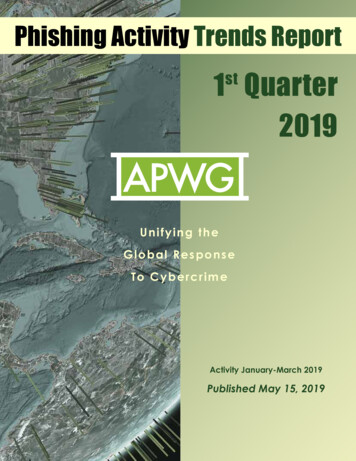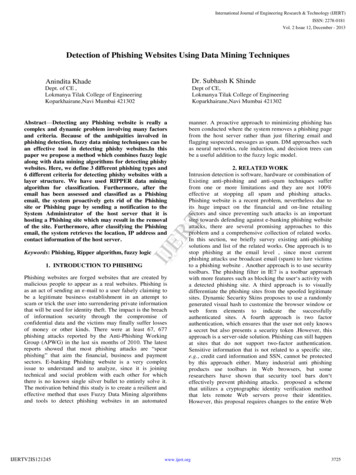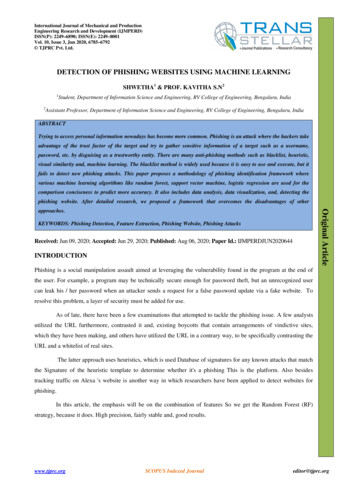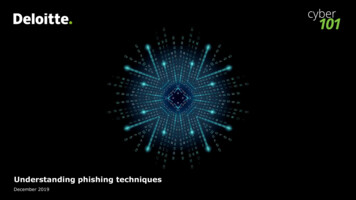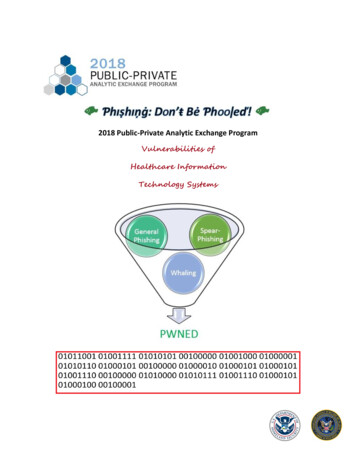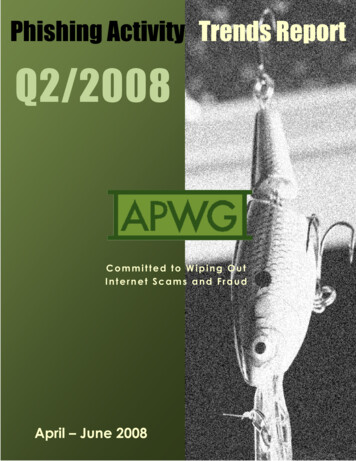
Transcription
Phishing Activity Trends ReportQ2/2008PhishingCommitted to Wiping OutInternet Scams and FraudApril – June 2008
Phishing Activity Trends Report, Q2 2008Crimeware-SpreadingSpreading Sites Rise Swiftlyin Q2 – Highest Number Ever RecordedPhishing Report ScopeThe quarterly APWG Phishinghishing Activity Trends Reportanalyzes phishing attacks reported to the APWG by itsmember companies, Global Research Partners, theorganization’s website at http://www.antiphishing.organd by email submissions toreportphishing@antiphishing.org. APWG also measuresthe evolution, proliferation and propagation ofcrimeware drawing from the research of our membercompanies. In the last half of this report you will findtabulations of crimeware statistics.Password Stealing Malicious Code URLsQ2/2007- Q2/20089529650045003200266035002880 276025603362408031132260Phishing DefinedPhishing is a criminal mechanism employing both socialengineering and technical subterfuge to steal consumersconsumers’personal identity data and financial account credentials.Social-engineering schemes use spoofed e-mailsmailspurporting to be from legitimate businesses and agenciesto lead consumers to counterfeit websites designed totrick recipients into divulging financial data such asusernames and passwords. Technical-subterfugesubterfugeschemes plant crimeware onto PCs to steal credentialsdirectly, often using systems to intercept consumersonline account user names and passwords - and tocorrupt local navigational infrastructures to misdirectconsumers to counterfeit websites (or authentic websitesthrough phisher-controlledcontrolled proxies used to monitor andintercept consumers’ keystrokes).The number of crimeware-spreadingspreading sites infecting PCs withpassword-stealing crimeware rose to a high of 9529 in June, fully47% higher than the previous record of 6500 in March 2008 and258% greater than the end of Q2/2008. Details on page 8.Q2 2008 Phishing Activity Trends Summary Unique phishing attack reports submitted to APWGrose 13 percent during the quarter to 28,151 in June Unique phishing websites reported to APWG in Junedecreased more than 9 percent from April to 18,509 May presented a record high of 294 hijacked brandsTable of Contentsand the quarter’s 485 victimized brands is alsoaa recordStatistical Highlights for Q1, 20083Phishing Email Reports and Phishing Site Trends4Brand-Domain Pairs Measurement56 The category of Other in the ‘Targeted Industrydue to attacks against social networkingnetwand national taxagencies. [Note:: reflects a change in APWG’s dataBrands & Legitimate Entities Hijacked byEmail Phishing Attacksexplained on page 3.]Segment’ measurement increased to 4 percent of the totalMost Used Ports Hosting Phishing DataCollection Servers in Q1 2008high. [Note:: reflects a change in APWG’s data sample,6sample, explained on page 3.]Most Targeted Industry Sectors7 The number malicious application variants hit a recordCountries Hosting Phishing Sites7Phishing-based Trojans – Keyloggers in Q1 20088high of 442 in MayPhishing-based Trojans & Downloader’s HostCountries (by IP address)29APWG Phishing Trends Report Contributors:Websense, ActivityMarkMonitor,& PandaSoftwareQ2 10PhishingTrendsReport2008www.apwg.org info@apwg.org The number of crimeware-spreadingspreading URLs exploded toa record high of 9529 at quarter’s end,end 258 percent higherthan at the end in of Q2 2007
Phishing Activity Trends Report, Q2 2008MethodologyAPWG continues to refine and develop our tracking and reporting methodology and to incorporate new datasources into our quarterly reports. We have re-instated the tracking and reporting of unique phishing reports (emailcampaigns) in addition to unique phishing sites. An email campaign is a unique email sent out to multiple users,directing them to a specific phishing web site (multiple campaigns may point to the same web site). APWG countsunique phishing report emails as those in a given month with the same subject line in the email.APWG also tracks the number of unique phishing websites. This is now determined by the unique base URLs of thephishing sites.APWG additionally tracks crimeware instances (unique software applications as determined by MD5 hash of thecrimeware sample) as well as unique sites that are distributing crimeware (typically via browser drive-by exploits).SPECIAL NOTE ON DATA SAMPLING: With this edition the APWG supplements the data sets utilized inestablishing trend lines for the numbers of brands under phishing attack as well as the concentration of those attacksin targeted industrial sectors, incorporating phishing attack data from APWG member and phish attack datacorrespondent MarkMonitor. The APWG Phishing Activity Trends Report is incorporating specifically the company’s‘Unique Brand’ data and attack data delineating industry sectors targeted in those phishing attacks.The supplemental data augments three report metrics covered in the APWG Phishing Activity Trends Report. Thoseare: ‘Brands & Legitimate Entities Hijacked by Email Phishing Attacks’ (Page 6), the ‘Brand-Domain PairsMeasurement’ (Page 5) and ‘The Most Targeted Industry Sectors’ (Page 7). The MarkMonitor targeted brandsamples averaged around 85 percent more brands than the APWG’s in 2008. The sample size is reflected in thehijacked brands measurement and the brand-domain pairs metric. The new targeted brand categorization dividesthe attack space into five sectors – financial services, auction services, payment services, retail and service companiesand other (which includes government, charities, ISPs and unclassified brands), replacing the APWG’s previous fourcategories of financial services, retail, ISPs and government and others.Statistical Highlights for Q2 2008AprilMayJuneNumber of unique phishing email reports received by APWG from consumers24,92423,76228,151Number of unique phishing web sites detected20,41020,31718,509276294227Country hosting the most phishing websitesChinaTurkeyUSContain some form of target name in URL28.3%23.2%26.1%No hostname; just IP address5.5%13.2%4%Percentage of sites not using port 80.81%.45%.49%30 days31 days30 daysNumber of brands hijacked by phishing campaignsLongest time online for website3Phishing Activity Trends Report Q2 2008www.apwg.org info@apwg.org
Phishing Activity Trends Report,The number of unique phishing reports submitted to13 percent ending at 28,151 in June, after declining tofrom the yearly high of 30,716 in February bySeptember of 2007. This represents a count ofPhishing Reports Received April30000249242500020000150001000050000AprilThe number of unique phishing websites detected by APWG during thedecrease during the month of June to 18,5094Phishing Activity Trends Report Q2www.apwg.org info@apwg.org
Phishing Activity Trends Report, Q2 2008Brand-Domain Pairs Measurement for Q2 2008The following chart combines statistics based on brands phished, unique domains, unique domain/brand pairs, andunique URLs. Brand/domain pairs count the unique instances of a domain being used to target a specific brand.Example:: if several URLs are targeting a brand – but are hosted on the same domain – this brand/domain pair wouldbe counted as one instead of several. [NOTE:: Please take note of special note on data sampling on page 3.]Forensic utility:: If the number of unique URLs is greater than the number of brand/domain pairs, it indicates manyURLs are being hosted on the same domain to target the same brand. Knowing how many URLs occur with eachdomain indicates the approximatete number of attacking domains a brandbrand-holdingholding victim needs to locate andneutralize. Since Phishing-preventionprevention technologies (like browser and email blocking) require the full URL, it isuseful to understand the general number of unique URLs that occur peper domain.Phishing Data and Brand-DomainDomain Pairs for Q2 200825,000350Unique brand-domaindomain pairs steadilydecreased during the period of Aprilthrough June, from 7,656 to rilMayJuneUnique Phishing Web Sites DetectedUnique DomainsUnique Brand-Domain PairsUnique BrandsWhile the number of unique Phish"WhileURL's declined in Q2, the number ofbrands targeted continues to rise," saidsaiBlake Hayward, Vice President ofProduct Marketing at MarkMonitor."This suggests that phishers areinvesting in sophisticated marketingtools and IT infrastructure in order toconduct more targetedrgeted spear phishingcampaigns,” Mr. Hayward said.URLs per BrandAprilMayJuneNumber of Unique Phishing Web Sites Detected20,41020,31718,509Unique Domains6,1765,8495,633Unique Brand-Domain Pairs7,6567,2676,768Unique Brands276294227URLs Per Brand7469825Phishing Activity Trends Report Q2 2008www.apwg.org info@apwg.org
Phishing Activity Trends Report, Q2 2008Most Used Ports Hosting Phishingng Data Collection Servers in Q2 2008The second quarter of 2008 saw a continuation of HTTP port 80 being the most popular port used of all phishingsites reported, a trend that has been consistent since APWG began tracking and reporting.AprilMayJunePort 8099.49%Port 8099.42%Port 8099.65%Port 5443.23%Port 82.16%Port 443.19%Port 443.22%Port 84.06%Port 84.06%Port 8080.06%Port 85.06%Port 81.03%Port 443.06%Port 9070.03%5 other.24%1 other.01%Brands and Legitimate Entities Hijacked by Email Phishing Attacks in Q2 2008The second quarter of 2008 saw a decrease of 28 percent in hijacked brands from 276 at the beginning of the quarterto 227 brands victimized at period’s end. In the data set used for this metric, May presented a record high of 294and the quarter’s 485 victimized brands is also a record high. [NOTE:: Please take note of special note on datasampling on page 3.]Hijacked Brands by Month Q2 2008350300276294227250200150100500April6Phishing Activity Trends Report Q2 2008www.apwg.org info@apwg.orgMayJune
Phishing Activity Trends Report, Q2 2008Most Targeted Industry Sectors in Q2 2008inancial Services continues to be the most targeted industry sector during the second quarter of 2008.2008 This isFinancialconsistent with results since the APWG began tracking targeted industry sectors. The uptick in the ‘Other’ categoryis the increase in targeted attacks towards social networking sites such as MySpace and Facebook in addition to taxagencies. May and June also saw a massive increase in attacks aimed at cell phone providers and manufactures.manufactures[NOTE: Please take note of specialecial note on data sampling on page 3.]Most Targeted Industry Sectorsin Q2 ervice18%Other4%Countriesies Hosting Phishing Sites in Q2 2008Turkey briefly took the top spot as the country hosting the largest number of phishing sites during the month ofMay. This rise is due to an ISP that was receiving extraordinarily large numbers of phishinging attacks. A hackerabusing the ISP’s IP space hosted a large number of fraudulent sites there. The United States remained in the toptwo of countries throughout the period, regaining the ttopop spot in June. China made a quick and massive jump to thetop spot in April after only rendering 3% of top countries hosting websites a month before in March.AprilMayJuneChina25.19%%Turkey25.73%United States18.93%United States16.68%%United a4.28%Republic of .08%Republic of Korea2.38%France2.32%Republic of %United Kingdom2.16%7Phishing Activity Trends Report Q2 2008www.apwg.org info@apwg.org
Phishing Activity Trends Report, Q2 2008Crimeware Taxonomy and Samples According to ClassificationThe APWG’s Crimeware statistics categorizes crimeware attacks as follows, though the taxonomy will grow asvariations in attack code are spawned:Definition: Crimeware code which is designed with the intent of collecting information on the endend-user in order tosteal those users' credentials. Unlikeke most generic keyloggers, phishingphishing-basedbased keyloggers have tracking componentswhich attempt to monitor specific actions (and specific organizations, most importantly financial institutionsinstitutions, onlineretailers, and e-commercecommerce merchants) in order to target spspecific information. Thehe most common types ofinformation are: access to financial-basedbased websites, ecommerce sites, and webweb-basedbased mail sites.Phishing-based Trojans – Keyloggers in Q2 2008The number of crimeware-spreadingspreading URLs detectedrose from 4,080 in April to a record 9,529 in June.This rise representedesented an increase of nearly 47percent from the previous record of 6,500 in March,2008. The number at quarter’s end is 258 percenthigher than the end of Q2 2007.Password Stealing Malicious Code URLs1200095291000080006000Websense Chief Technology Officer and APWGPhishing Activity Trends Report contributing analystDan Hubbard said that the large boost is attributedmainly to malicious code being utilized in SQLinjection attacks.40803113400020000AprilPassword Stealing Malicious Code yJune8Phishing Activity Trends Report Q2 2008www.apwg.org info@apwg.orgMayJune.eyloggers andanThe number of unique keyloggerscrimeware-oriented malicious applications alsoreached an all-time high this quarter reaching442 in May,, 1 percent higher than the previouspreviorecord the month before and 105 percent higherthan in May 2007 when the number ofcrimeware variants detected was 216.216 Criminalhackers have apparently redoubled their effortsto develop new techniques and scripts to bypasssecurity measures taken by consumers andenterprises – in addition to increasing thenumbers of crimeware-spreadingspreading websites.websites
Phishing Activity Trends Report, Q2 2008Phishing-based Trojans – RedirectorsDefinition: Crimeware code which is designed with the intent of redirecting end-users’ network traffic to a locationwhere it was not intended to go to. This includes crimeware that changes hosts files and other DNS-specificinformation, crimeware browser-helper objects that redirect users to fraudulent sites, and crimeware that may installa network level driver or filter to redirect users to fraudulent locations. All of these must be installed with theintention of compromising information which could lead to identify theft or other credentials being taken withcriminal intent.Along with phishing-based keyloggers, we are seeing high increases in traffic redirectors. In particular, the highestvolume is in malicious code which simply modifies your DNS server settings or your hosts file to redirect eithersome specific DNS lookups or all DNS lookups to a fraudulent DNS server. The fraudulent server replies with“good” answers for most domains; however, when they want to direct you to a fraudulent one, they simply modifytheir name server responses. This is particularly effective because the attackers can redirect any of the users requestsat any time and the end-users have very little indication that this is happening as they could be typing in the addresson their own and not following an email or Instant Messaging lure.Phishing-based Trojans and Downloader’s Hosting Countries (by IP address)The chart below represents a breakdown of the websites which were classified during Q2 2008 as hosting maliciouscode in the form of either a phishing-based keylogger or a Trojan downloader which downloads a keylogger.AprilMayJuneUnited States38.67%United States32.12%United Russia5.74%Republic of ic of Korea2.17%Italy1.96%Republic of 1.79%Poland1.52%Italy1.46%United Kingdom1.75%9Phishing Activity Trends Report Q2 2008www.apwg.org info@apwg.org
Phishing Activity Trends Report, Q2 2008Phishing Report ContributorsMarkMonitor, the globalPandaLabs is an internationalWebsense Security Labs’leader in enterprise brandnetwork of research andmission is to discover,protection, offerstechnical support centersinvestigate, and report oncomprehensive solutions anddevoted to protecting usersadvanced internet threats toservices that safeguardagainst malware.protect employee computingenvironments.brands, reputation andrevenue from online risks.The Phishing Attack Trends Report is published quarterly by the APWG, an industry and law enforcementassociation focused on eliminating the identity theft and fraud that result from the growing problem of phishing,crimeware, and email spoofing. For further information, please contact APWG Deputy Secretary General FoyShiver at 404.434.7282. For media inquiries please contact APWG Secretary General Peter Cassidy at 617.669.1123or Cas Purdy at 858.320.9493 or cpurdy@websense.com or Te Smith at 831.818.1267 orTe.Smith@markmonitor.com. APWG thanks its contributing members, above, for data and analyses in this report.About the APWGThe APWG, founded as the Anti-Phishing Working Group in 2003, is an industry association focused on eliminating theidentity theft and fraud that result from the growing problem of phishing and email spoofing. The organization providesa forum to discuss phishing issues, define the scope of the phishing problem in terms of hard and soft costs andconsequences, and to share information and best practices for eliminating the problem.Membership is open to qualified financial institutions, online retailers, ISPs, the law enforcement community, andsolutions providers. There are more than 1,800 companies and government agencies participating in the APWG and morethan 3,200 members. Note that because phishing attacks and email fraud are sensitive subjects for many organizationsthat do business online, the APWG has a policy of maintaining the confidentiality of member organizations.The website of the APWG is http://www.antiphishing.org. It serves as a resource for information about the problem ofphishing and electronic frauds perpetrated against personal computers and their users. The APWG, a 501c6 tax-exemptedcorporation, was founded by Tumbleweed Communications, financial services institutions and e-commerce providers.APWG’s first meeting was in November 2003 in San Francisco and in June 2004 was incorporated as an independentcorporation controlled by its steering committee, its board of directors, and its executives.10Phishing Activity Trends Report Q2 2008www.apwg.org info@apwg.org
Phishing Data and Brand-Domain Pairs for Q2 2008 Brand-Domain Pairs Measurement for Q2 2008 Q2 2008 - but are hosted on the same domain - this brand/domain pair would [NOTE: Please take note of special note on data sampling on page 3.]-holding victim needs to locate and r domain. April May 20,410 20,317 6,176 5,849 7,656 7,267 276 294 74 69 .
